Comparative Analysis of Construction Procurement Strategies Report
VerifiedAdded on 2021/05/27
|18
|4180
|45
Report
AI Summary
This report provides a comparative analysis of three major construction procurement methods: Design-Build (D&C), Design-Bid-Build (Traditional), and Partnering. It begins by defining D&C, highlighting its key characteristics such as cost certainty, reduced legal responsibility, and faster project timelines. The report details the implementation process, advantages like single-point responsibility and reduced project time, and disadvantages including the need for a clear initial brief and limited access for small contractors. The Design-Bid-Build method, or traditional method, is then examined, outlining its sequential process, key characteristics, and implementation. The advantages, such as fairness to bidders and owner's needs being safeguarded, are discussed alongside disadvantages like potential delays and conflicts. Finally, the report explores Partnering, emphasizing its focus on improving relationships between stakeholders and fostering collaboration. The key characteristics, implementation process, and advantages, such as improved stakeholder relationships, are presented. The report concludes with a comprehensive comparison of these methods, offering insights into their suitability for different project types and objectives.
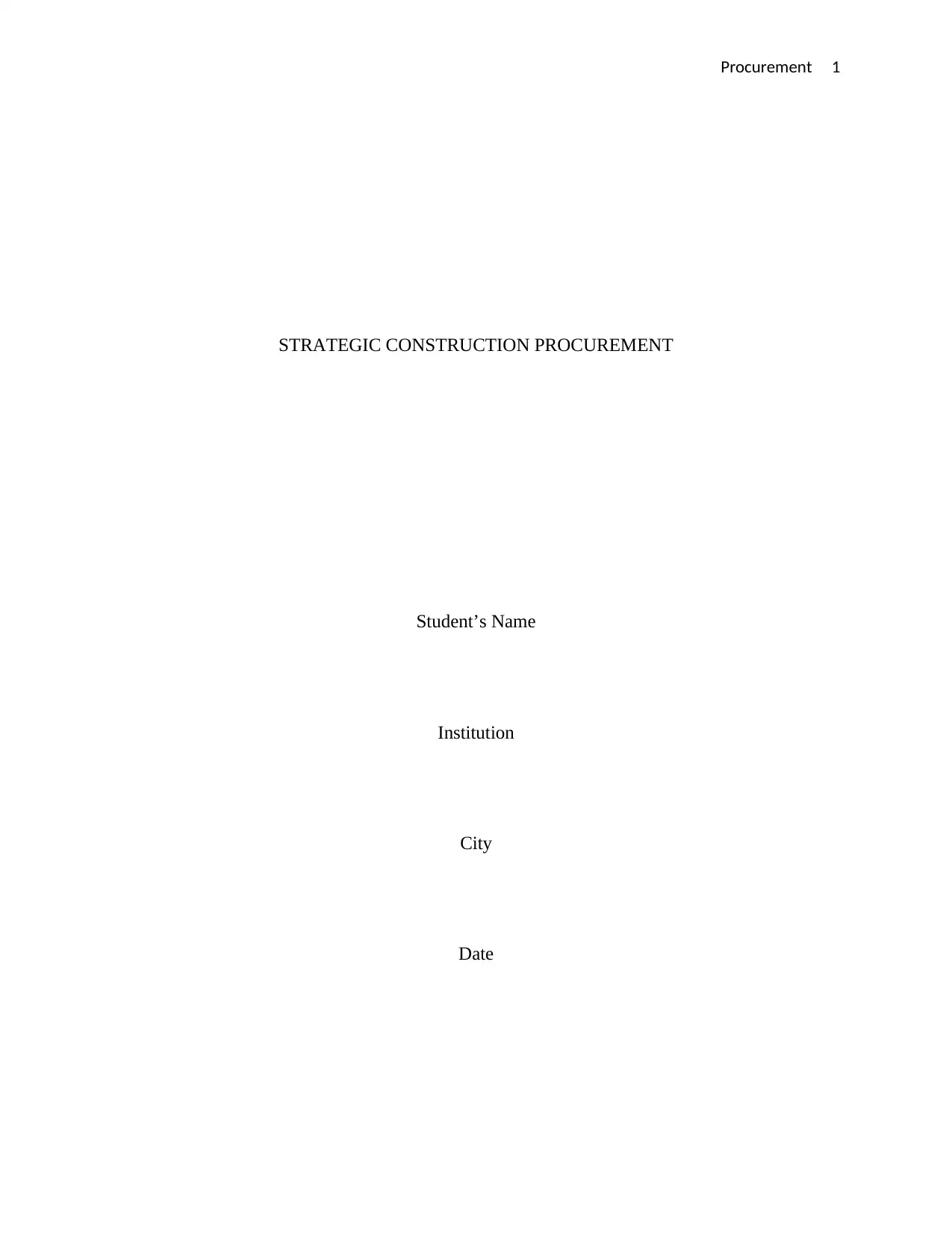
Procurement 1
STRATEGIC CONSTRUCTION PROCUREMENT
Student’s Name
Institution
City
Date
STRATEGIC CONSTRUCTION PROCUREMENT
Student’s Name
Institution
City
Date
Paraphrase This Document
Need a fresh take? Get an instant paraphrase of this document with our AI Paraphraser
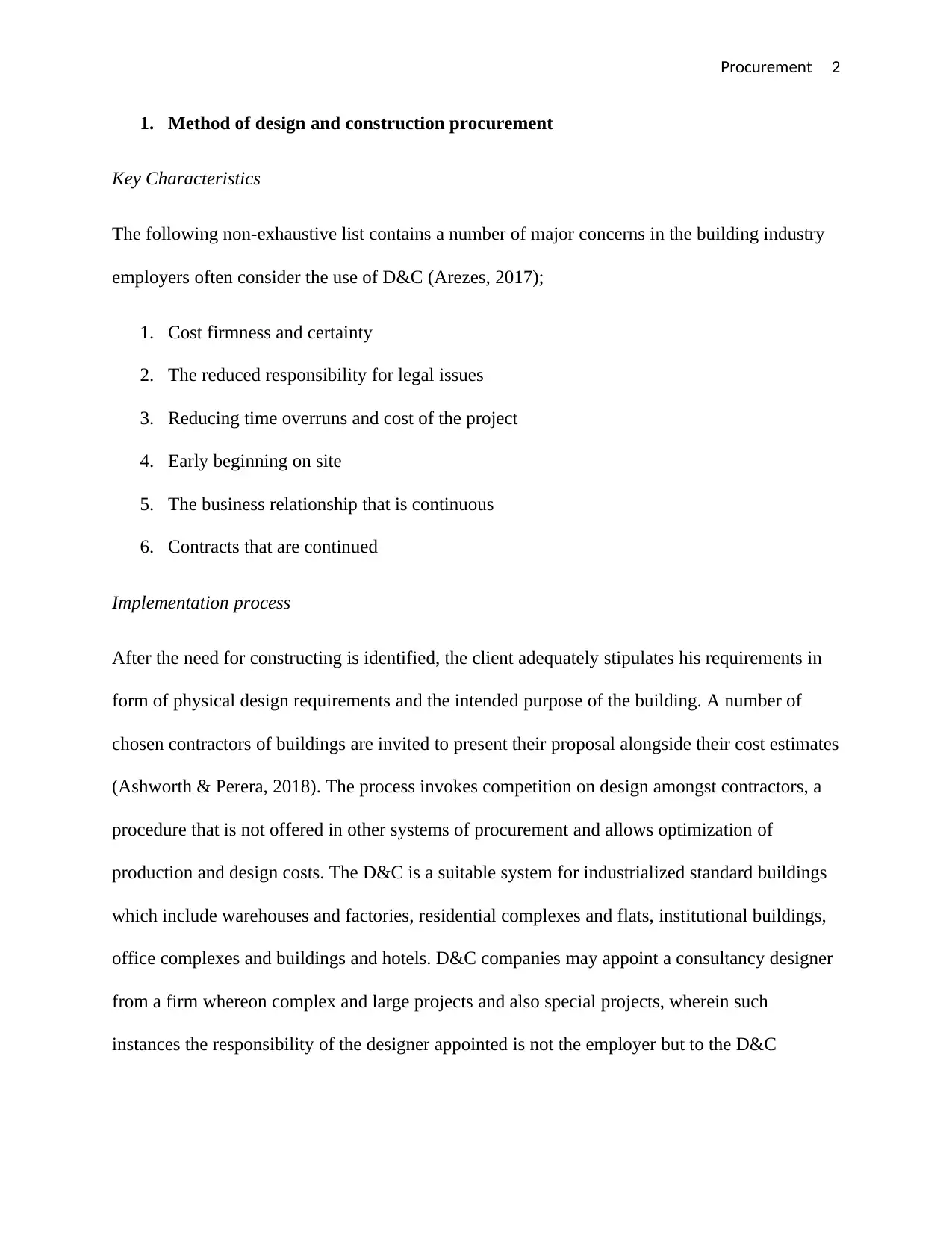
Procurement 2
1. Method of design and construction procurement
Key Characteristics
The following non-exhaustive list contains a number of major concerns in the building industry
employers often consider the use of D&C (Arezes, 2017);
1. Cost firmness and certainty
2. The reduced responsibility for legal issues
3. Reducing time overruns and cost of the project
4. Early beginning on site
5. The business relationship that is continuous
6. Contracts that are continued
Implementation process
After the need for constructing is identified, the client adequately stipulates his requirements in
form of physical design requirements and the intended purpose of the building. A number of
chosen contractors of buildings are invited to present their proposal alongside their cost estimates
(Ashworth & Perera, 2018). The process invokes competition on design amongst contractors, a
procedure that is not offered in other systems of procurement and allows optimization of
production and design costs. The D&C is a suitable system for industrialized standard buildings
which include warehouses and factories, residential complexes and flats, institutional buildings,
office complexes and buildings and hotels. D&C companies may appoint a consultancy designer
from a firm whereon complex and large projects and also special projects, wherein such
instances the responsibility of the designer appointed is not the employer but to the D&C
1. Method of design and construction procurement
Key Characteristics
The following non-exhaustive list contains a number of major concerns in the building industry
employers often consider the use of D&C (Arezes, 2017);
1. Cost firmness and certainty
2. The reduced responsibility for legal issues
3. Reducing time overruns and cost of the project
4. Early beginning on site
5. The business relationship that is continuous
6. Contracts that are continued
Implementation process
After the need for constructing is identified, the client adequately stipulates his requirements in
form of physical design requirements and the intended purpose of the building. A number of
chosen contractors of buildings are invited to present their proposal alongside their cost estimates
(Ashworth & Perera, 2018). The process invokes competition on design amongst contractors, a
procedure that is not offered in other systems of procurement and allows optimization of
production and design costs. The D&C is a suitable system for industrialized standard buildings
which include warehouses and factories, residential complexes and flats, institutional buildings,
office complexes and buildings and hotels. D&C companies may appoint a consultancy designer
from a firm whereon complex and large projects and also special projects, wherein such
instances the responsibility of the designer appointed is not the employer but to the D&C
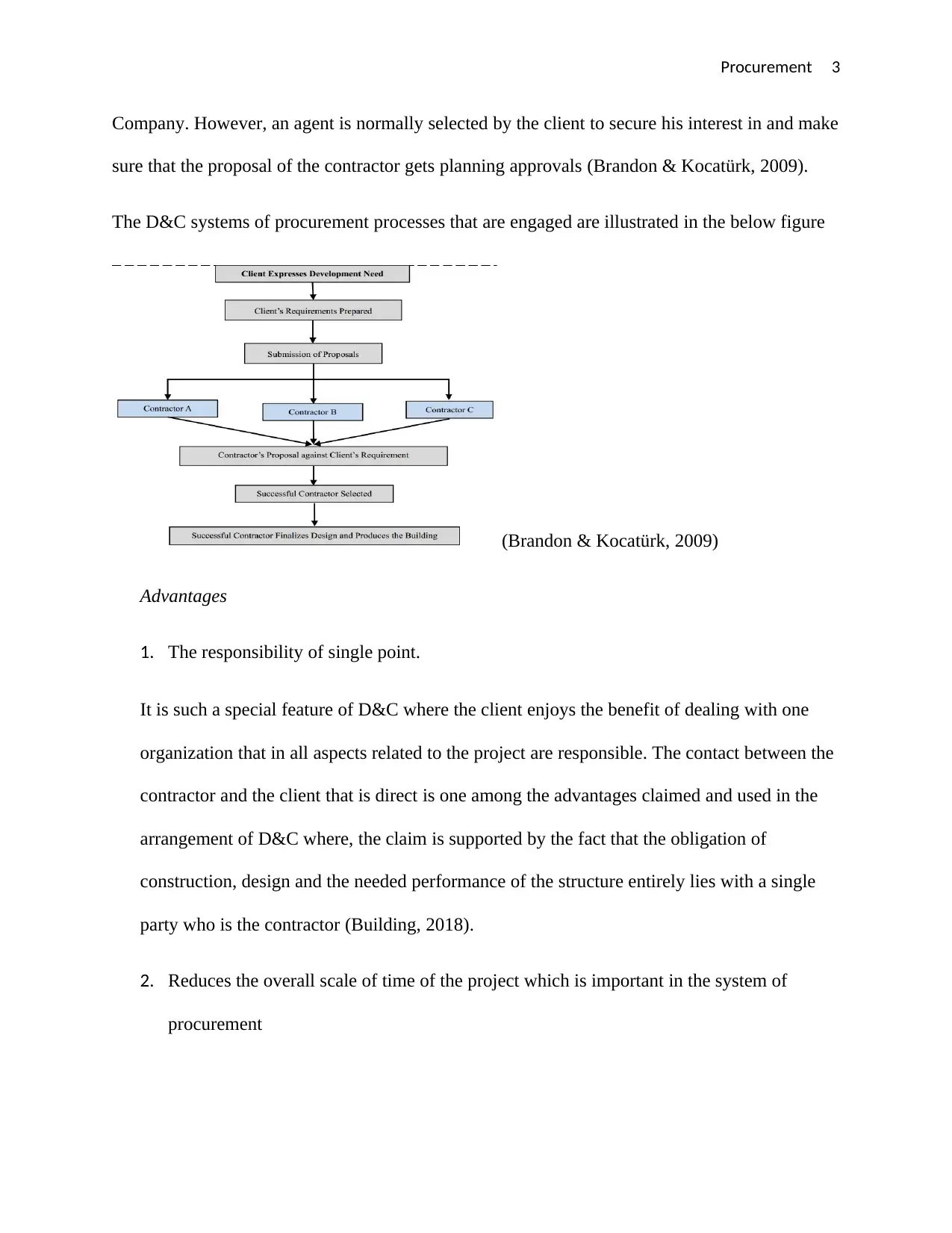
Procurement 3
Company. However, an agent is normally selected by the client to secure his interest in and make
sure that the proposal of the contractor gets planning approvals (Brandon & Kocatürk, 2009).
The D&C systems of procurement processes that are engaged are illustrated in the below figure
(Brandon & Kocatürk, 2009)
Advantages
1. The responsibility of single point.
It is such a special feature of D&C where the client enjoys the benefit of dealing with one
organization that in all aspects related to the project are responsible. The contact between the
contractor and the client that is direct is one among the advantages claimed and used in the
arrangement of D&C where, the claim is supported by the fact that the obligation of
construction, design and the needed performance of the structure entirely lies with a single
party who is the contractor (Building, 2018).
2. Reduces the overall scale of time of the project which is important in the system of
procurement
Company. However, an agent is normally selected by the client to secure his interest in and make
sure that the proposal of the contractor gets planning approvals (Brandon & Kocatürk, 2009).
The D&C systems of procurement processes that are engaged are illustrated in the below figure
(Brandon & Kocatürk, 2009)
Advantages
1. The responsibility of single point.
It is such a special feature of D&C where the client enjoys the benefit of dealing with one
organization that in all aspects related to the project are responsible. The contact between the
contractor and the client that is direct is one among the advantages claimed and used in the
arrangement of D&C where, the claim is supported by the fact that the obligation of
construction, design and the needed performance of the structure entirely lies with a single
party who is the contractor (Building, 2018).
2. Reduces the overall scale of time of the project which is important in the system of
procurement
⊘ This is a preview!⊘
Do you want full access?
Subscribe today to unlock all pages.

Trusted by 1+ million students worldwide
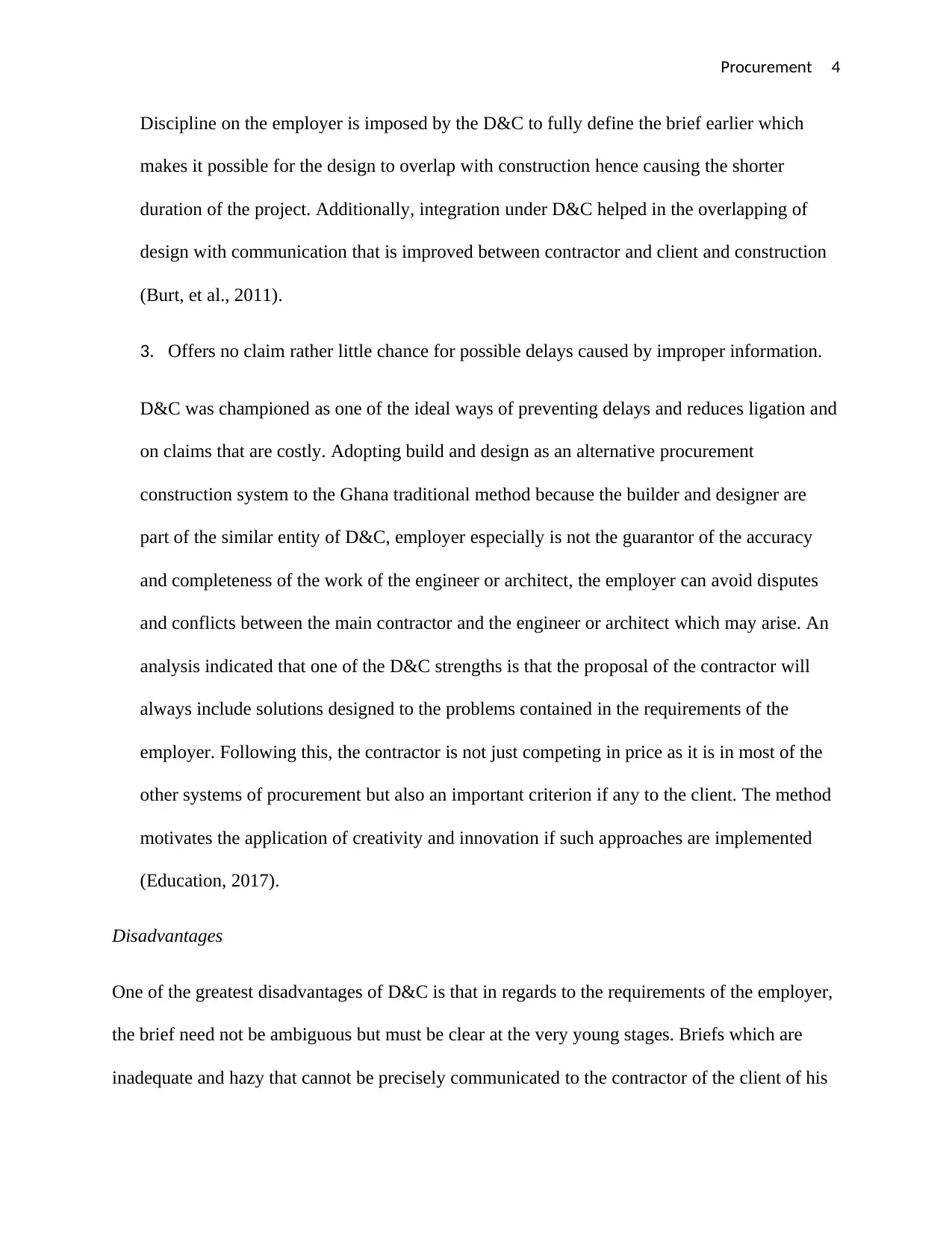
Procurement 4
Discipline on the employer is imposed by the D&C to fully define the brief earlier which
makes it possible for the design to overlap with construction hence causing the shorter
duration of the project. Additionally, integration under D&C helped in the overlapping of
design with communication that is improved between contractor and client and construction
(Burt, et al., 2011).
3. Offers no claim rather little chance for possible delays caused by improper information.
D&C was championed as one of the ideal ways of preventing delays and reduces ligation and
on claims that are costly. Adopting build and design as an alternative procurement
construction system to the Ghana traditional method because the builder and designer are
part of the similar entity of D&C, employer especially is not the guarantor of the accuracy
and completeness of the work of the engineer or architect, the employer can avoid disputes
and conflicts between the main contractor and the engineer or architect which may arise. An
analysis indicated that one of the D&C strengths is that the proposal of the contractor will
always include solutions designed to the problems contained in the requirements of the
employer. Following this, the contractor is not just competing in price as it is in most of the
other systems of procurement but also an important criterion if any to the client. The method
motivates the application of creativity and innovation if such approaches are implemented
(Education, 2017).
Disadvantages
One of the greatest disadvantages of D&C is that in regards to the requirements of the employer,
the brief need not be ambiguous but must be clear at the very young stages. Briefs which are
inadequate and hazy that cannot be precisely communicated to the contractor of the client of his
Discipline on the employer is imposed by the D&C to fully define the brief earlier which
makes it possible for the design to overlap with construction hence causing the shorter
duration of the project. Additionally, integration under D&C helped in the overlapping of
design with communication that is improved between contractor and client and construction
(Burt, et al., 2011).
3. Offers no claim rather little chance for possible delays caused by improper information.
D&C was championed as one of the ideal ways of preventing delays and reduces ligation and
on claims that are costly. Adopting build and design as an alternative procurement
construction system to the Ghana traditional method because the builder and designer are
part of the similar entity of D&C, employer especially is not the guarantor of the accuracy
and completeness of the work of the engineer or architect, the employer can avoid disputes
and conflicts between the main contractor and the engineer or architect which may arise. An
analysis indicated that one of the D&C strengths is that the proposal of the contractor will
always include solutions designed to the problems contained in the requirements of the
employer. Following this, the contractor is not just competing in price as it is in most of the
other systems of procurement but also an important criterion if any to the client. The method
motivates the application of creativity and innovation if such approaches are implemented
(Education, 2017).
Disadvantages
One of the greatest disadvantages of D&C is that in regards to the requirements of the employer,
the brief need not be ambiguous but must be clear at the very young stages. Briefs which are
inadequate and hazy that cannot be precisely communicated to the contractor of the client of his
Paraphrase This Document
Need a fresh take? Get an instant paraphrase of this document with our AI Paraphraser
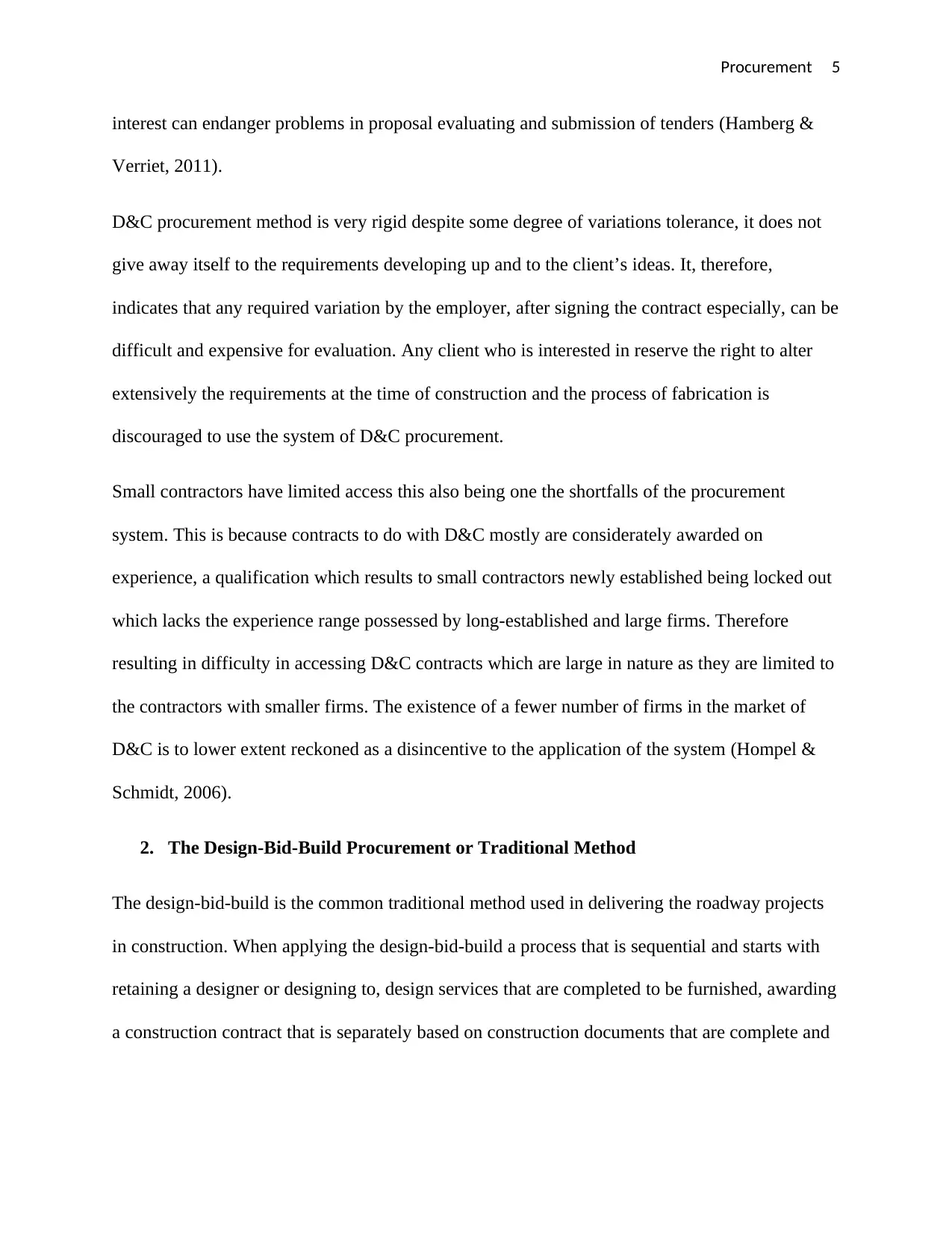
Procurement 5
interest can endanger problems in proposal evaluating and submission of tenders (Hamberg &
Verriet, 2011).
D&C procurement method is very rigid despite some degree of variations tolerance, it does not
give away itself to the requirements developing up and to the client’s ideas. It, therefore,
indicates that any required variation by the employer, after signing the contract especially, can be
difficult and expensive for evaluation. Any client who is interested in reserve the right to alter
extensively the requirements at the time of construction and the process of fabrication is
discouraged to use the system of D&C procurement.
Small contractors have limited access this also being one the shortfalls of the procurement
system. This is because contracts to do with D&C mostly are considerately awarded on
experience, a qualification which results to small contractors newly established being locked out
which lacks the experience range possessed by long-established and large firms. Therefore
resulting in difficulty in accessing D&C contracts which are large in nature as they are limited to
the contractors with smaller firms. The existence of a fewer number of firms in the market of
D&C is to lower extent reckoned as a disincentive to the application of the system (Hompel &
Schmidt, 2006).
2. The Design-Bid-Build Procurement or Traditional Method
The design-bid-build is the common traditional method used in delivering the roadway projects
in construction. When applying the design-bid-build a process that is sequential and starts with
retaining a designer or designing to, design services that are completed to be furnished, awarding
a construction contract that is separately based on construction documents that are complete and
interest can endanger problems in proposal evaluating and submission of tenders (Hamberg &
Verriet, 2011).
D&C procurement method is very rigid despite some degree of variations tolerance, it does not
give away itself to the requirements developing up and to the client’s ideas. It, therefore,
indicates that any required variation by the employer, after signing the contract especially, can be
difficult and expensive for evaluation. Any client who is interested in reserve the right to alter
extensively the requirements at the time of construction and the process of fabrication is
discouraged to use the system of D&C procurement.
Small contractors have limited access this also being one the shortfalls of the procurement
system. This is because contracts to do with D&C mostly are considerately awarded on
experience, a qualification which results to small contractors newly established being locked out
which lacks the experience range possessed by long-established and large firms. Therefore
resulting in difficulty in accessing D&C contracts which are large in nature as they are limited to
the contractors with smaller firms. The existence of a fewer number of firms in the market of
D&C is to lower extent reckoned as a disincentive to the application of the system (Hompel &
Schmidt, 2006).
2. The Design-Bid-Build Procurement or Traditional Method
The design-bid-build is the common traditional method used in delivering the roadway projects
in construction. When applying the design-bid-build a process that is sequential and starts with
retaining a designer or designing to, design services that are completed to be furnished, awarding
a construction contract that is separately based on construction documents that are complete and
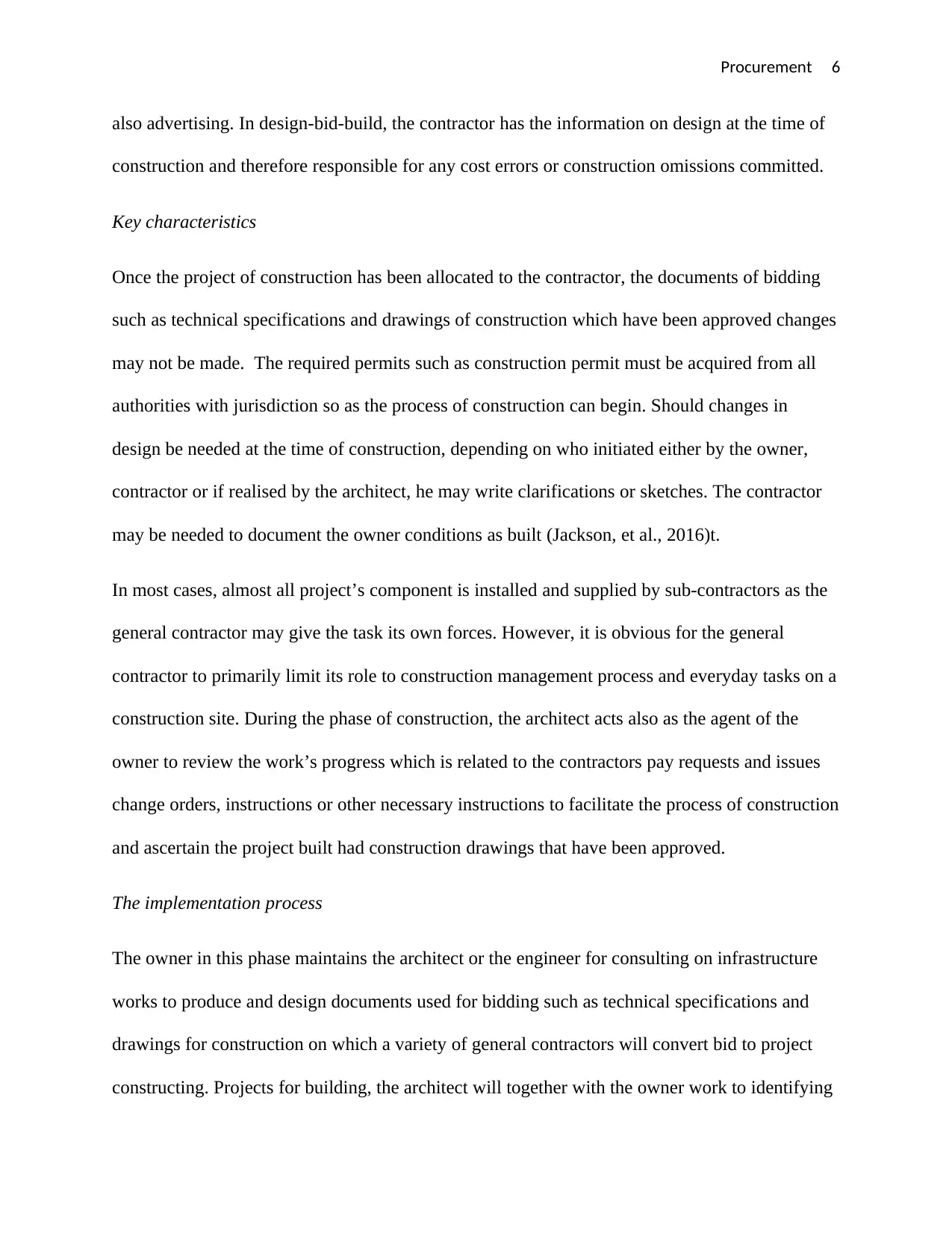
Procurement 6
also advertising. In design-bid-build, the contractor has the information on design at the time of
construction and therefore responsible for any cost errors or construction omissions committed.
Key characteristics
Once the project of construction has been allocated to the contractor, the documents of bidding
such as technical specifications and drawings of construction which have been approved changes
may not be made. The required permits such as construction permit must be acquired from all
authorities with jurisdiction so as the process of construction can begin. Should changes in
design be needed at the time of construction, depending on who initiated either by the owner,
contractor or if realised by the architect, he may write clarifications or sketches. The contractor
may be needed to document the owner conditions as built (Jackson, et al., 2016)t.
In most cases, almost all project’s component is installed and supplied by sub-contractors as the
general contractor may give the task its own forces. However, it is obvious for the general
contractor to primarily limit its role to construction management process and everyday tasks on a
construction site. During the phase of construction, the architect acts also as the agent of the
owner to review the work’s progress which is related to the contractors pay requests and issues
change orders, instructions or other necessary instructions to facilitate the process of construction
and ascertain the project built had construction drawings that have been approved.
The implementation process
The owner in this phase maintains the architect or the engineer for consulting on infrastructure
works to produce and design documents used for bidding such as technical specifications and
drawings for construction on which a variety of general contractors will convert bid to project
constructing. Projects for building, the architect will together with the owner work to identifying
also advertising. In design-bid-build, the contractor has the information on design at the time of
construction and therefore responsible for any cost errors or construction omissions committed.
Key characteristics
Once the project of construction has been allocated to the contractor, the documents of bidding
such as technical specifications and drawings of construction which have been approved changes
may not be made. The required permits such as construction permit must be acquired from all
authorities with jurisdiction so as the process of construction can begin. Should changes in
design be needed at the time of construction, depending on who initiated either by the owner,
contractor or if realised by the architect, he may write clarifications or sketches. The contractor
may be needed to document the owner conditions as built (Jackson, et al., 2016)t.
In most cases, almost all project’s component is installed and supplied by sub-contractors as the
general contractor may give the task its own forces. However, it is obvious for the general
contractor to primarily limit its role to construction management process and everyday tasks on a
construction site. During the phase of construction, the architect acts also as the agent of the
owner to review the work’s progress which is related to the contractors pay requests and issues
change orders, instructions or other necessary instructions to facilitate the process of construction
and ascertain the project built had construction drawings that have been approved.
The implementation process
The owner in this phase maintains the architect or the engineer for consulting on infrastructure
works to produce and design documents used for bidding such as technical specifications and
drawings for construction on which a variety of general contractors will convert bid to project
constructing. Projects for building, the architect will together with the owner work to identifying
⊘ This is a preview!⊘
Do you want full access?
Subscribe today to unlock all pages.

Trusted by 1+ million students worldwide
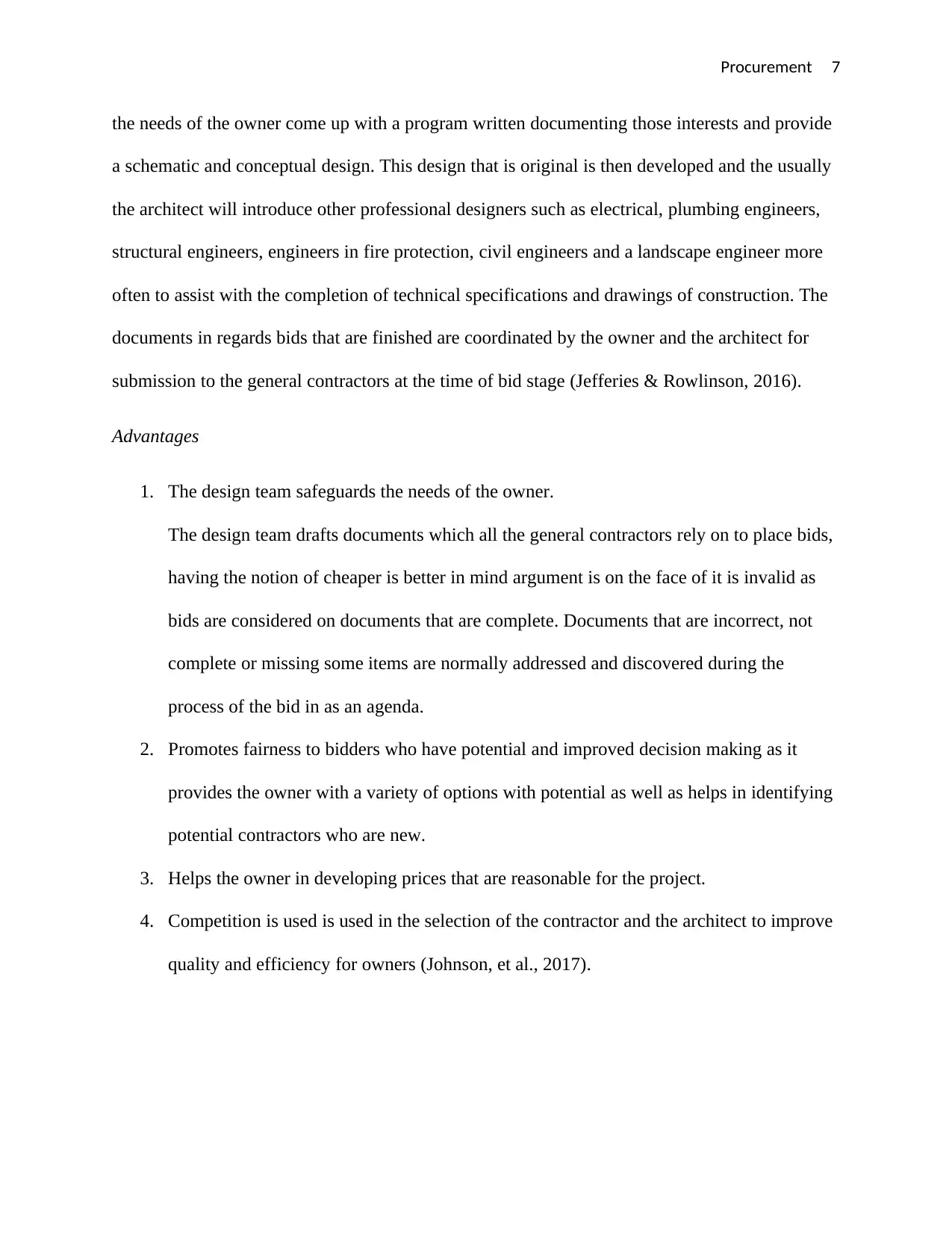
Procurement 7
the needs of the owner come up with a program written documenting those interests and provide
a schematic and conceptual design. This design that is original is then developed and the usually
the architect will introduce other professional designers such as electrical, plumbing engineers,
structural engineers, engineers in fire protection, civil engineers and a landscape engineer more
often to assist with the completion of technical specifications and drawings of construction. The
documents in regards bids that are finished are coordinated by the owner and the architect for
submission to the general contractors at the time of bid stage (Jefferies & Rowlinson, 2016).
Advantages
1. The design team safeguards the needs of the owner.
The design team drafts documents which all the general contractors rely on to place bids,
having the notion of cheaper is better in mind argument is on the face of it is invalid as
bids are considered on documents that are complete. Documents that are incorrect, not
complete or missing some items are normally addressed and discovered during the
process of the bid in as an agenda.
2. Promotes fairness to bidders who have potential and improved decision making as it
provides the owner with a variety of options with potential as well as helps in identifying
potential contractors who are new.
3. Helps the owner in developing prices that are reasonable for the project.
4. Competition is used is used in the selection of the contractor and the architect to improve
quality and efficiency for owners (Johnson, et al., 2017).
the needs of the owner come up with a program written documenting those interests and provide
a schematic and conceptual design. This design that is original is then developed and the usually
the architect will introduce other professional designers such as electrical, plumbing engineers,
structural engineers, engineers in fire protection, civil engineers and a landscape engineer more
often to assist with the completion of technical specifications and drawings of construction. The
documents in regards bids that are finished are coordinated by the owner and the architect for
submission to the general contractors at the time of bid stage (Jefferies & Rowlinson, 2016).
Advantages
1. The design team safeguards the needs of the owner.
The design team drafts documents which all the general contractors rely on to place bids,
having the notion of cheaper is better in mind argument is on the face of it is invalid as
bids are considered on documents that are complete. Documents that are incorrect, not
complete or missing some items are normally addressed and discovered during the
process of the bid in as an agenda.
2. Promotes fairness to bidders who have potential and improved decision making as it
provides the owner with a variety of options with potential as well as helps in identifying
potential contractors who are new.
3. Helps the owner in developing prices that are reasonable for the project.
4. Competition is used is used in the selection of the contractor and the architect to improve
quality and efficiency for owners (Johnson, et al., 2017).
Paraphrase This Document
Need a fresh take? Get an instant paraphrase of this document with our AI Paraphraser
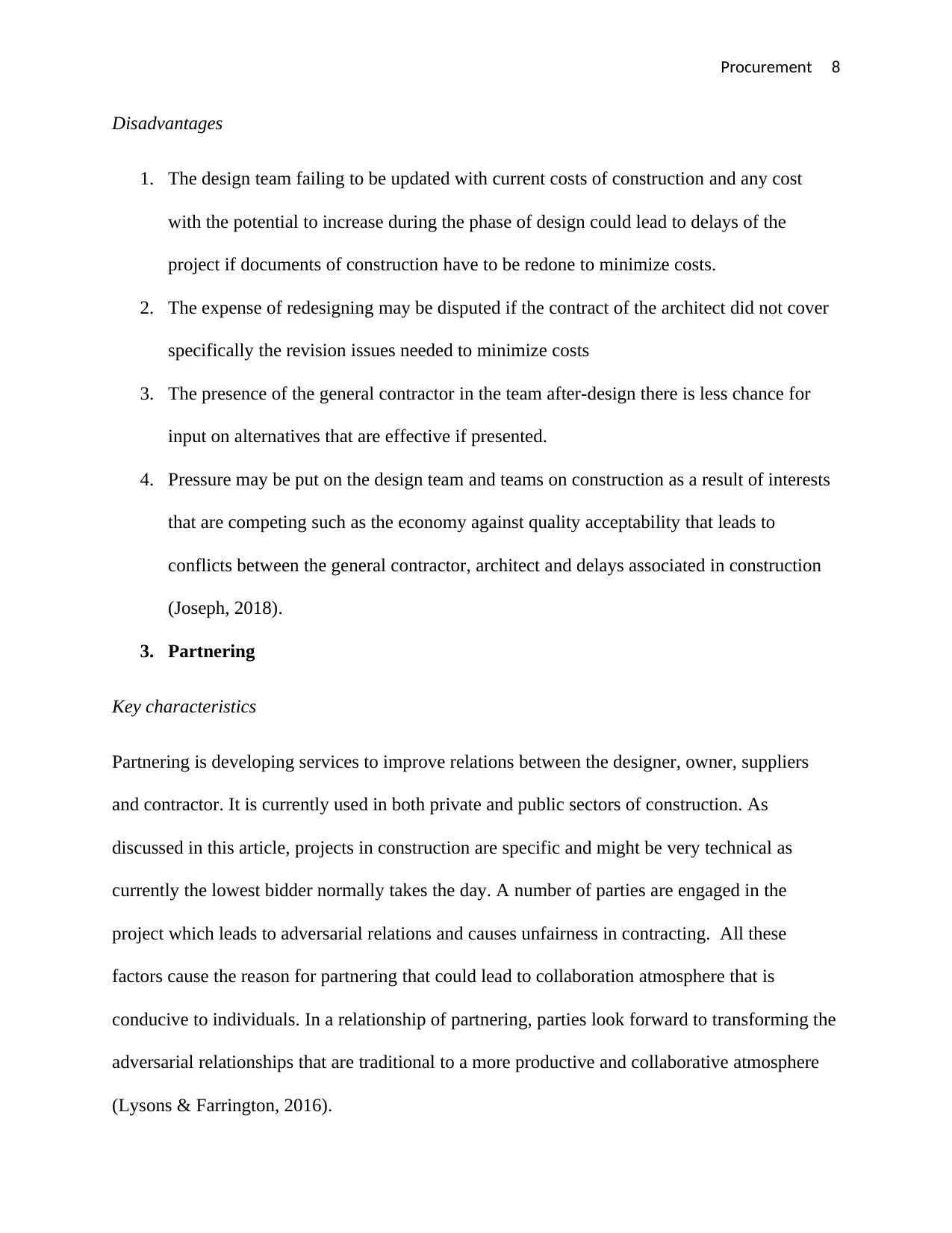
Procurement 8
Disadvantages
1. The design team failing to be updated with current costs of construction and any cost
with the potential to increase during the phase of design could lead to delays of the
project if documents of construction have to be redone to minimize costs.
2. The expense of redesigning may be disputed if the contract of the architect did not cover
specifically the revision issues needed to minimize costs
3. The presence of the general contractor in the team after-design there is less chance for
input on alternatives that are effective if presented.
4. Pressure may be put on the design team and teams on construction as a result of interests
that are competing such as the economy against quality acceptability that leads to
conflicts between the general contractor, architect and delays associated in construction
(Joseph, 2018).
3. Partnering
Key characteristics
Partnering is developing services to improve relations between the designer, owner, suppliers
and contractor. It is currently used in both private and public sectors of construction. As
discussed in this article, projects in construction are specific and might be very technical as
currently the lowest bidder normally takes the day. A number of parties are engaged in the
project which leads to adversarial relations and causes unfairness in contracting. All these
factors cause the reason for partnering that could lead to collaboration atmosphere that is
conducive to individuals. In a relationship of partnering, parties look forward to transforming the
adversarial relationships that are traditional to a more productive and collaborative atmosphere
(Lysons & Farrington, 2016).
Disadvantages
1. The design team failing to be updated with current costs of construction and any cost
with the potential to increase during the phase of design could lead to delays of the
project if documents of construction have to be redone to minimize costs.
2. The expense of redesigning may be disputed if the contract of the architect did not cover
specifically the revision issues needed to minimize costs
3. The presence of the general contractor in the team after-design there is less chance for
input on alternatives that are effective if presented.
4. Pressure may be put on the design team and teams on construction as a result of interests
that are competing such as the economy against quality acceptability that leads to
conflicts between the general contractor, architect and delays associated in construction
(Joseph, 2018).
3. Partnering
Key characteristics
Partnering is developing services to improve relations between the designer, owner, suppliers
and contractor. It is currently used in both private and public sectors of construction. As
discussed in this article, projects in construction are specific and might be very technical as
currently the lowest bidder normally takes the day. A number of parties are engaged in the
project which leads to adversarial relations and causes unfairness in contracting. All these
factors cause the reason for partnering that could lead to collaboration atmosphere that is
conducive to individuals. In a relationship of partnering, parties look forward to transforming the
adversarial relationships that are traditional to a more productive and collaborative atmosphere
(Lysons & Farrington, 2016).
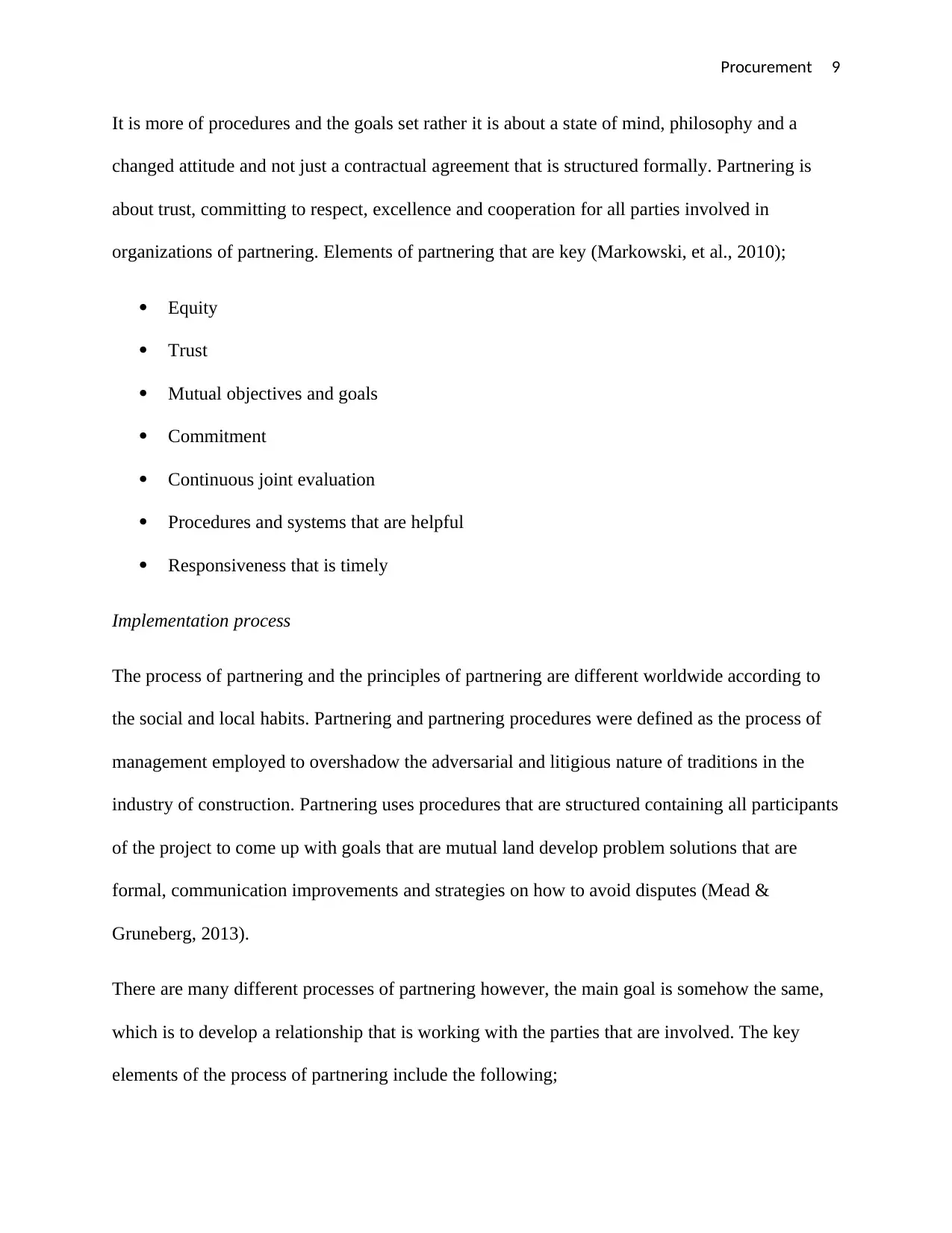
Procurement 9
It is more of procedures and the goals set rather it is about a state of mind, philosophy and a
changed attitude and not just a contractual agreement that is structured formally. Partnering is
about trust, committing to respect, excellence and cooperation for all parties involved in
organizations of partnering. Elements of partnering that are key (Markowski, et al., 2010);
Equity
Trust
Mutual objectives and goals
Commitment
Continuous joint evaluation
Procedures and systems that are helpful
Responsiveness that is timely
Implementation process
The process of partnering and the principles of partnering are different worldwide according to
the social and local habits. Partnering and partnering procedures were defined as the process of
management employed to overshadow the adversarial and litigious nature of traditions in the
industry of construction. Partnering uses procedures that are structured containing all participants
of the project to come up with goals that are mutual land develop problem solutions that are
formal, communication improvements and strategies on how to avoid disputes (Mead &
Gruneberg, 2013).
There are many different processes of partnering however, the main goal is somehow the same,
which is to develop a relationship that is working with the parties that are involved. The key
elements of the process of partnering include the following;
It is more of procedures and the goals set rather it is about a state of mind, philosophy and a
changed attitude and not just a contractual agreement that is structured formally. Partnering is
about trust, committing to respect, excellence and cooperation for all parties involved in
organizations of partnering. Elements of partnering that are key (Markowski, et al., 2010);
Equity
Trust
Mutual objectives and goals
Commitment
Continuous joint evaluation
Procedures and systems that are helpful
Responsiveness that is timely
Implementation process
The process of partnering and the principles of partnering are different worldwide according to
the social and local habits. Partnering and partnering procedures were defined as the process of
management employed to overshadow the adversarial and litigious nature of traditions in the
industry of construction. Partnering uses procedures that are structured containing all participants
of the project to come up with goals that are mutual land develop problem solutions that are
formal, communication improvements and strategies on how to avoid disputes (Mead &
Gruneberg, 2013).
There are many different processes of partnering however, the main goal is somehow the same,
which is to develop a relationship that is working with the parties that are involved. The key
elements of the process of partnering include the following;
⊘ This is a preview!⊘
Do you want full access?
Subscribe today to unlock all pages.

Trusted by 1+ million students worldwide
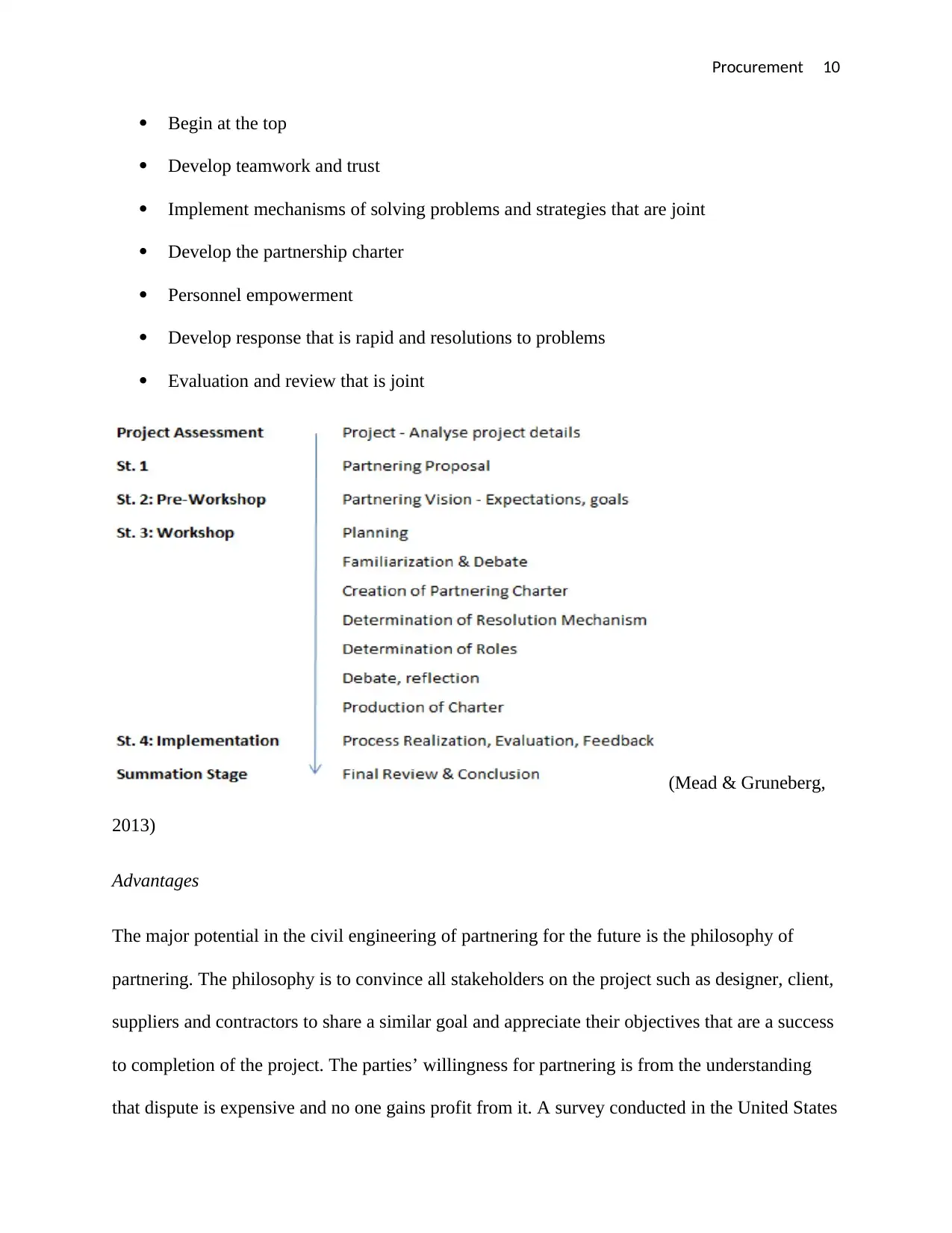
Procurement 10
Begin at the top
Develop teamwork and trust
Implement mechanisms of solving problems and strategies that are joint
Develop the partnership charter
Personnel empowerment
Develop response that is rapid and resolutions to problems
Evaluation and review that is joint
(Mead & Gruneberg,
2013)
Advantages
The major potential in the civil engineering of partnering for the future is the philosophy of
partnering. The philosophy is to convince all stakeholders on the project such as designer, client,
suppliers and contractors to share a similar goal and appreciate their objectives that are a success
to completion of the project. The parties’ willingness for partnering is from the understanding
that dispute is expensive and no one gains profit from it. A survey conducted in the United States
Begin at the top
Develop teamwork and trust
Implement mechanisms of solving problems and strategies that are joint
Develop the partnership charter
Personnel empowerment
Develop response that is rapid and resolutions to problems
Evaluation and review that is joint
(Mead & Gruneberg,
2013)
Advantages
The major potential in the civil engineering of partnering for the future is the philosophy of
partnering. The philosophy is to convince all stakeholders on the project such as designer, client,
suppliers and contractors to share a similar goal and appreciate their objectives that are a success
to completion of the project. The parties’ willingness for partnering is from the understanding
that dispute is expensive and no one gains profit from it. A survey conducted in the United States
Paraphrase This Document
Need a fresh take? Get an instant paraphrase of this document with our AI Paraphraser
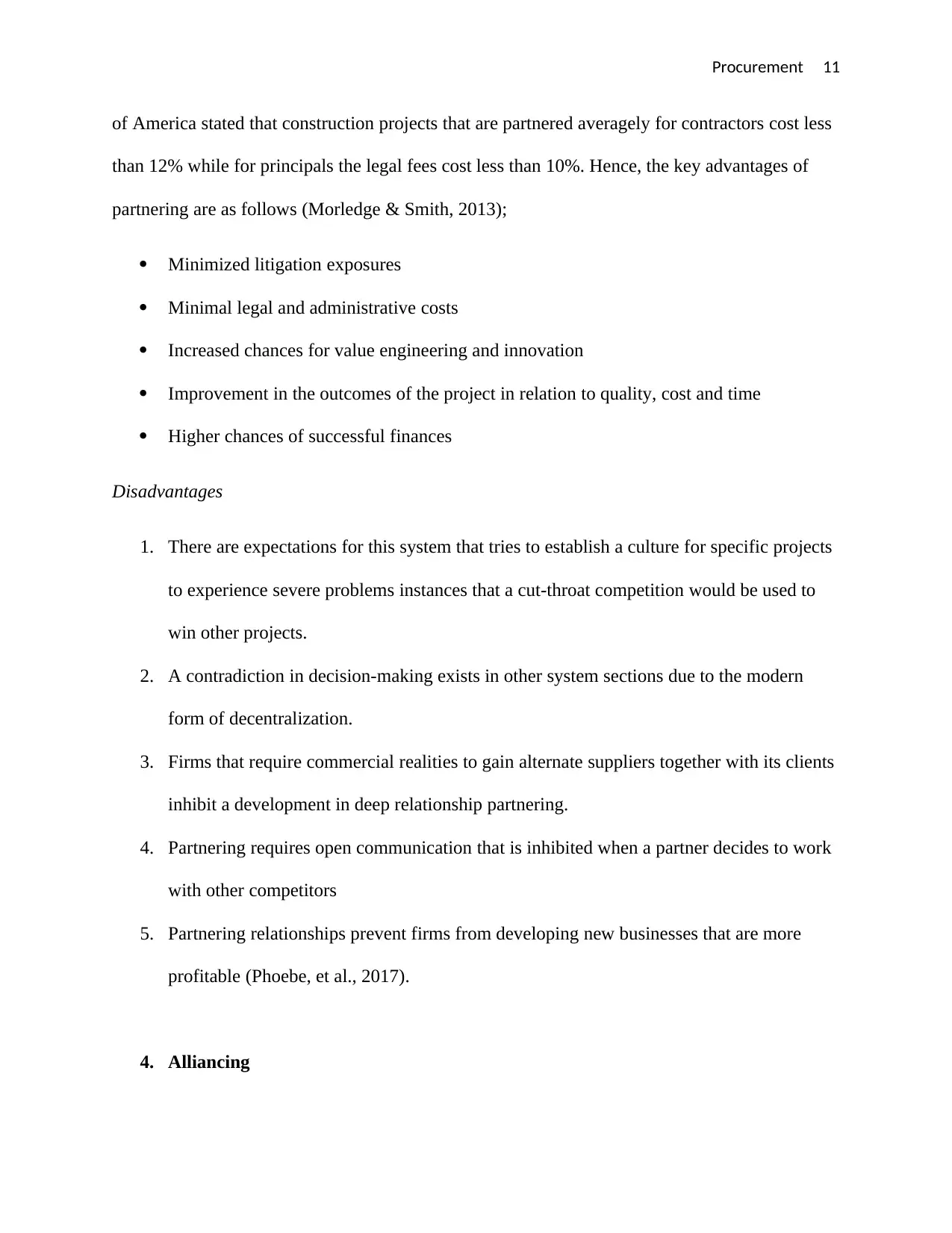
Procurement 11
of America stated that construction projects that are partnered averagely for contractors cost less
than 12% while for principals the legal fees cost less than 10%. Hence, the key advantages of
partnering are as follows (Morledge & Smith, 2013);
Minimized litigation exposures
Minimal legal and administrative costs
Increased chances for value engineering and innovation
Improvement in the outcomes of the project in relation to quality, cost and time
Higher chances of successful finances
Disadvantages
1. There are expectations for this system that tries to establish a culture for specific projects
to experience severe problems instances that a cut-throat competition would be used to
win other projects.
2. A contradiction in decision-making exists in other system sections due to the modern
form of decentralization.
3. Firms that require commercial realities to gain alternate suppliers together with its clients
inhibit a development in deep relationship partnering.
4. Partnering requires open communication that is inhibited when a partner decides to work
with other competitors
5. Partnering relationships prevent firms from developing new businesses that are more
profitable (Phoebe, et al., 2017).
4. Alliancing
of America stated that construction projects that are partnered averagely for contractors cost less
than 12% while for principals the legal fees cost less than 10%. Hence, the key advantages of
partnering are as follows (Morledge & Smith, 2013);
Minimized litigation exposures
Minimal legal and administrative costs
Increased chances for value engineering and innovation
Improvement in the outcomes of the project in relation to quality, cost and time
Higher chances of successful finances
Disadvantages
1. There are expectations for this system that tries to establish a culture for specific projects
to experience severe problems instances that a cut-throat competition would be used to
win other projects.
2. A contradiction in decision-making exists in other system sections due to the modern
form of decentralization.
3. Firms that require commercial realities to gain alternate suppliers together with its clients
inhibit a development in deep relationship partnering.
4. Partnering requires open communication that is inhibited when a partner decides to work
with other competitors
5. Partnering relationships prevent firms from developing new businesses that are more
profitable (Phoebe, et al., 2017).
4. Alliancing
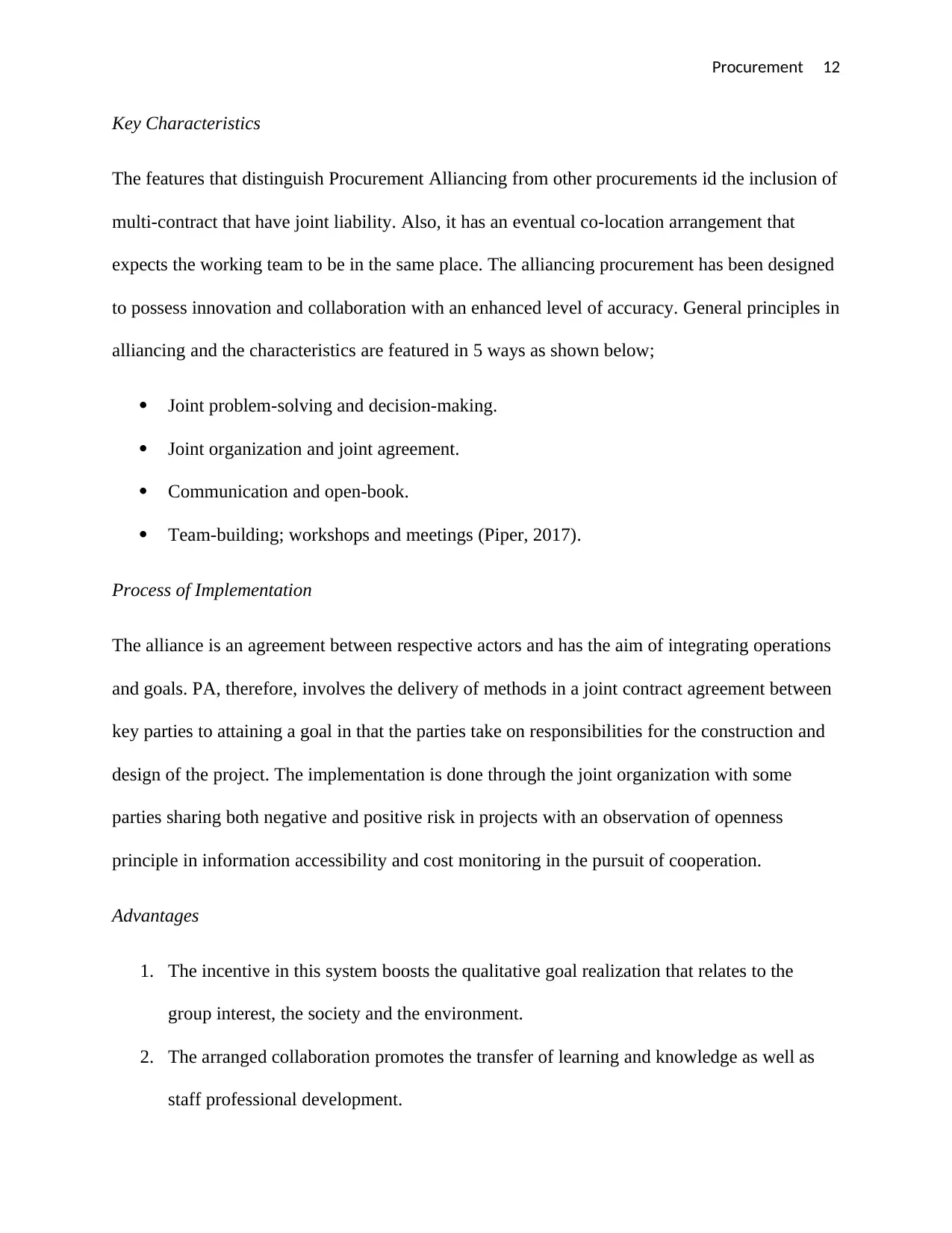
Procurement 12
Key Characteristics
The features that distinguish Procurement Alliancing from other procurements id the inclusion of
multi-contract that have joint liability. Also, it has an eventual co-location arrangement that
expects the working team to be in the same place. The alliancing procurement has been designed
to possess innovation and collaboration with an enhanced level of accuracy. General principles in
alliancing and the characteristics are featured in 5 ways as shown below;
Joint problem-solving and decision-making.
Joint organization and joint agreement.
Communication and open-book.
Team-building; workshops and meetings (Piper, 2017).
Process of Implementation
The alliance is an agreement between respective actors and has the aim of integrating operations
and goals. PA, therefore, involves the delivery of methods in a joint contract agreement between
key parties to attaining a goal in that the parties take on responsibilities for the construction and
design of the project. The implementation is done through the joint organization with some
parties sharing both negative and positive risk in projects with an observation of openness
principle in information accessibility and cost monitoring in the pursuit of cooperation.
Advantages
1. The incentive in this system boosts the qualitative goal realization that relates to the
group interest, the society and the environment.
2. The arranged collaboration promotes the transfer of learning and knowledge as well as
staff professional development.
Key Characteristics
The features that distinguish Procurement Alliancing from other procurements id the inclusion of
multi-contract that have joint liability. Also, it has an eventual co-location arrangement that
expects the working team to be in the same place. The alliancing procurement has been designed
to possess innovation and collaboration with an enhanced level of accuracy. General principles in
alliancing and the characteristics are featured in 5 ways as shown below;
Joint problem-solving and decision-making.
Joint organization and joint agreement.
Communication and open-book.
Team-building; workshops and meetings (Piper, 2017).
Process of Implementation
The alliance is an agreement between respective actors and has the aim of integrating operations
and goals. PA, therefore, involves the delivery of methods in a joint contract agreement between
key parties to attaining a goal in that the parties take on responsibilities for the construction and
design of the project. The implementation is done through the joint organization with some
parties sharing both negative and positive risk in projects with an observation of openness
principle in information accessibility and cost monitoring in the pursuit of cooperation.
Advantages
1. The incentive in this system boosts the qualitative goal realization that relates to the
group interest, the society and the environment.
2. The arranged collaboration promotes the transfer of learning and knowledge as well as
staff professional development.
⊘ This is a preview!⊘
Do you want full access?
Subscribe today to unlock all pages.

Trusted by 1+ million students worldwide
1 out of 18
Related Documents
Your All-in-One AI-Powered Toolkit for Academic Success.
+13062052269
info@desklib.com
Available 24*7 on WhatsApp / Email
![[object Object]](/_next/static/media/star-bottom.7253800d.svg)
Unlock your academic potential
Copyright © 2020–2025 A2Z Services. All Rights Reserved. Developed and managed by ZUCOL.





